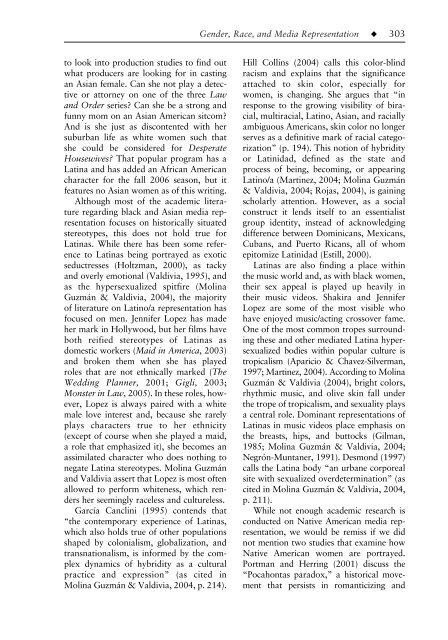Gender, race, and media representation - afghan
Gender, race, and media representation - afghan
Gender, race, and media representation - afghan
You also want an ePaper? Increase the reach of your titles
YUMPU automatically turns print PDFs into web optimized ePapers that Google loves.
16-Dow-4973.qxd 6/11/2006 1:42 PM Page 303<br />
to look into production studies to find out<br />
what producers are looking for in casting<br />
an Asian female. Can she not play a detective<br />
or attorney on one of the three Law<br />
<strong>and</strong> Order series? Can she be a strong <strong>and</strong><br />
funny mom on an Asian American sitcom?<br />
And is she just as discontented with her<br />
suburban life as white women such that<br />
she could be considered for Desperate<br />
Housewives? That popular program has a<br />
Latina <strong>and</strong> has added an African American<br />
character for the fall 2006 season, but it<br />
features no Asian women as of this writing.<br />
Although most of the academic literature<br />
regarding black <strong>and</strong> Asian <strong>media</strong> <strong>representation</strong><br />
focuses on historically situated<br />
stereotypes, this does not hold true for<br />
Latinas. While there has been some reference<br />
to Latinas being portrayed as exotic<br />
seductresses (Holtzman, 2000), as tacky<br />
<strong>and</strong> overly emotional (Valdivia, 1995), <strong>and</strong><br />
as the hypersexualized spitfire (Molina<br />
Guzmán & Valdivia, 2004), the majority<br />
of literature on Latino/a <strong>representation</strong> has<br />
focused on men. Jennifer Lopez has made<br />
her mark in Hollywood, but her films have<br />
both reified stereotypes of Latinas as<br />
domestic workers (Maid in America, 2003)<br />
<strong>and</strong> broken them when she has played<br />
roles that are not ethnically marked (The<br />
Wedding Planner, 2001; Gigli, 2003;<br />
Monster in Law, 2005). In these roles, however,<br />
Lopez is always paired with a white<br />
male love interest <strong>and</strong>, because she rarely<br />
plays characters true to her ethnicity<br />
(except of course when she played a maid,<br />
a role that emphasized it), she becomes an<br />
assimilated character who does nothing to<br />
negate Latina stereotypes. Molina Guzmán<br />
<strong>and</strong> Valdivia assert that Lopez is most often<br />
allowed to perform whiteness, which renders<br />
her seemingly <strong>race</strong>less <strong>and</strong> cultureless.<br />
García Canclini (1995) contends that<br />
“the contemporary experience of Latinas,<br />
which also holds true of other populations<br />
shaped by colonialism, globalization, <strong>and</strong><br />
transnationalism, is informed by the complex<br />
dynamics of hybridity as a cultural<br />
practice <strong>and</strong> expression” (as cited in<br />
Molina Guzmán & Valdivia, 2004, p. 214).<br />
<strong>Gender</strong>, Race, <strong>and</strong> Media Representation–––◆–––303<br />
Hill Collins (2004) calls this color-blind<br />
racism <strong>and</strong> explains that the significance<br />
attached to skin color, especially for<br />
women, is changing. She argues that “in<br />
response to the growing visibility of biracial,<br />
multiracial, Latino, Asian, <strong>and</strong> racially<br />
ambiguous Americans, skin color no longer<br />
serves as a definitive mark of racial categorization”<br />
(p. 194). This notion of hybridity<br />
or Latinidad, defined as the state <strong>and</strong><br />
process of being, becoming, or appearing<br />
Latino/a (Martinez, 2004; Molina Guzmán<br />
& Valdivia, 2004; Rojas, 2004), is gaining<br />
scholarly attention. However, as a social<br />
construct it lends itself to an essentialist<br />
group identity, instead of acknowledging<br />
difference between Dominicans, Mexicans,<br />
Cubans, <strong>and</strong> Puerto Ricans, all of whom<br />
epitomize Latinidad (Estill, 2000).<br />
Latinas are also finding a place within<br />
the music world <strong>and</strong>, as with black women,<br />
their sex appeal is played up heavily in<br />
their music videos. Shakira <strong>and</strong> Jennifer<br />
Lopez are some of the most visible who<br />
have enjoyed music/acting crossover fame.<br />
One of the most common tropes surrounding<br />
these <strong>and</strong> other <strong>media</strong>ted Latina hypersexualized<br />
bodies within popular culture is<br />
tropicalism (Aparicio & Chavez-Silverman,<br />
1997; Martinez, 2004). According to Molina<br />
Guzmán & Valdivia (2004), bright colors,<br />
rhythmic music, <strong>and</strong> olive skin fall under<br />
the trope of tropicalism, <strong>and</strong> sexuality plays<br />
a central role. Dominant <strong>representation</strong>s of<br />
Latinas in music videos place emphasis on<br />
the breasts, hips, <strong>and</strong> buttocks (Gilman,<br />
1985; Molina Guzmán & Valdivia, 2004;<br />
Negrón-Muntaner, 1991). Desmond (1997)<br />
calls the Latina body “an urbane corporeal<br />
site with sexualized overdetermination” (as<br />
cited in Molina Guzmán & Valdivia, 2004,<br />
p. 211).<br />
While not enough academic research is<br />
conducted on Native American <strong>media</strong> <strong>representation</strong>,<br />
we would be remiss if we did<br />
not mention two studies that examine how<br />
Native American women are portrayed.<br />
Portman <strong>and</strong> Herring (2001) discuss the<br />
“Pocahontas paradox,” a historical movement<br />
that persists in romanticizing <strong>and</strong>




